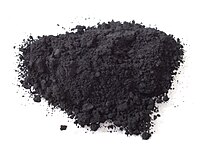
Photo from wikipedia
Sustainable development of mankind urgently recalls for decreasing the cost of energy storage. Continuous massive consumption of dedicated carbon electrode materials with complex internal molecular architecture calls for re-thinking both… Click to show full abstract
Sustainable development of mankind urgently recalls for decreasing the cost of energy storage. Continuous massive consumption of dedicated carbon electrode materials with complex internal molecular architecture calls for re-thinking both the source of materials and the process of their production. Finding an efficient sustainable solution is focused on the reuse and development of waste processing into corresponding high-value-added carbon materials. The processing of solid wastes into solid value-added carbon materials ("solid-to-solid") is relatively well developed but can be a two-stage process involving carbon architecture rearrangement and heteroatom doping. Processing liquid wastes into high-value-added solid material ("liquid-to-solid") is typically much more challenging with the need for different production equipment. In the present study, a new approach is developed to bypass the difficulty in the "liquid-to-solid" conversion and simultaneously built in the ability for heteroatom doping within one production stage. Polycondensation of liquid humins waste with melamine (as a nitrogen-containing cross-linking component) results in solidification with preferential C and N atomic arrangements. A complete sequence is reported in the present study, including liquid waste processing, nitrogen incorporation, carbon material production, structural study of the obtained materials, detailed electrochemical evaluation and real supercapacitor device manufacture and testing.
Journal Title: ChemSusChem
Year Published: 2023
Link to full text (if available)
Share on Social Media: Sign Up to like & get
recommendations!